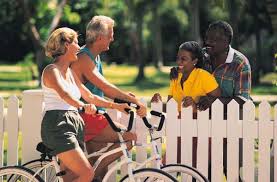Neighborhood Location Evaluation 101
 Location is a huge factor in successful homeownership. Just a mile—in some cases just a city block—can make a difference in home values, health risks, crime and the general quality of life for you and your family. Everyone has different priorities, but neighborhoods that are more likely to cause trouble for your housing investment often share certain qualities. What makes or breaks a neighborhood, and what are the signs of decline? Here are four ways to evaluate an area:
Location is a huge factor in successful homeownership. Just a mile—in some cases just a city block—can make a difference in home values, health risks, crime and the general quality of life for you and your family. Everyone has different priorities, but neighborhoods that are more likely to cause trouble for your housing investment often share certain qualities. What makes or breaks a neighborhood, and what are the signs of decline? Here are four ways to evaluate an area:
Home Prices
Sale prices in an area offer a good barometer of what’s happening on the ground. A neighborhood where homes linger on the market for years, where owners constantly drop their selling prices or sell for much lower than they initially asked for, might not serve as a great investment for a new home buyer. Most of that information is publicly available. A REALTOR® can answer questions too. Pay very close attention to small fluctuations in urban areas. In San Francisco, for example, by merely crossing to the other side of the street you can pay up to 25% more for a comparable house.
Looks That Aren’t Deceiving
If you see streets dotted with “out of business” signs, or if the schools look in dire need of upgrades, the area may not be for you. Evaluate the quality of transportation—areas with better transit options tend to hold their value more. If you spy dirty streets, poor local services, few recreational facilities, or a shortage of restaurants and other amenities, you may be witnessing signs of a neighborhood in decline. Purchasing property in such an area could put your investment at risk and create havoc in your daily life.
Focus on the Details
If you’re looking at a specific house or apartment, pay close attention to what’s nearby. Some things that might signal a less desirable area:
- Lots of traffic and noise
- Potential hazards such as a power plant
- Built on a landfill or former swampland
- Roads and sidewalks in disrepair
- Shabby, rundown or vacant buildings
- Near railroad tracks, under flight paths
- Near commercial or industrial areas
Careless Neighbors
Driving through a prospective neighborhood and looking at the condition of properties nearby can help you spot other signs of a declining neighborhood. Poor yard maintenance, shoddy landscaping, discarded junk in driveways, gardens growing weeds and broken fences could mean owners lack pride in their homes, and possibly in their community.
Courtesy of Yahoo Real Estate
[optima_express_search_results cityId=”3321″ propertyType=”SFR” minPrice=”300000″ maxPrice=”650000″ sortBy=”pa” header=”true” includeMap=”false”]
